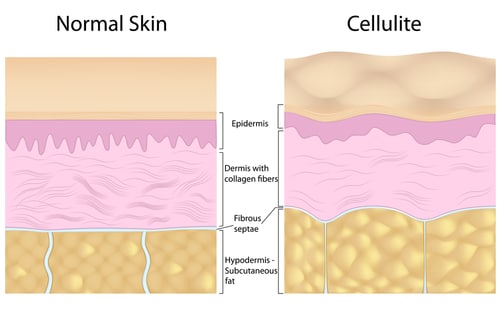
Cellulite Myths: Only Women Get Cellulite
Women make up the majority of cellulite sufferers but men can get it too. Males enjoy some protection against cellulite, which is really just subcutaneous fat poking through the dermal layer of the skin. For one, women have a thinner dermis, making cellulite more visible. Plus, the connective tissue bands that hold skin against muscle are constructed differently from a man’s. In women, fibrous bands of connective tissue are arranged in such a way that fat can herniate upwards through gaps between the bands and become visible as cellulite, especially as the dermis thins with age.
Men aren’t immune to cellulite but it’s far more common in women. Other factors that contribute to cellulite are inflammation and poor lymph circulation.
Cellulite Myths: Thin Women Don’t Get It
Thin women get cellulite too, but having a lower body fat percentage helps since cellulite is subcutaneous fat. Still, being slender is no guarantee of being cellulite free. Genetics play a role too since genetic factors impact how thick your dermis is and how the connective tissue bands that keep cellulite in place are constructed.
Here’s the bad news. If your mom had cellulite, you are at higher risk. Hormonal changes play a role too since cellulite increases during pregnancy. It also becomes more common with age as the dermis thins and the fibrous bands and connective tissue change in structure.
Cellulite Myths: Topical Creams Improve the Appearance of Cellulite
There’s no proof that topical creams have a major impact on cellulite. Topical creams that contain methylxanthines were once popular for treating cellulite. Methylxanthines promote the breakdown of subcutaneous fat but they don’t penetrate deeply enough to dissolve enough fat to make a real difference. They may slightly decrease your thigh circumference but the effect isn’t dramatic and it’s only temporary.
Some research suggests that topical retinoids, a vitamin A derivative available by prescription to treat acne and aging skin may help, although this hasn’t been sufficiently studied. It makes sense that using retinoids topically for 3 months or more might offer some benefit since it increases the thickness of the dermis. This should make cellulite less visible. A study carried out in 1999 showed some benefit but more research is needed.
Popular herbal creams people use to treat cellulite may slightly improve its appearance but only temporarily. Massage, another popular treatment for cellulite, also helps a little by boosting lymphatic drainage and reducing tissue swelling, but like herbal creams, the results aren’t long-lasting. Endermologie, a form of deeper massage, that involves suction also offers temporary improvement in how cellulite looks but is far from a cure.
Cellulite Myths: Liposuction Cures Cellulite
It sounds like a good solution but lipo can actually make cellulite worse. Even though liposuction removes subcutaneous fat, it doesn’t remove it evenly. This can lead to uneven fat distribution underneath the skin that looks even worse. Liposuction is not an effective treatment for cellulite.
Cellulite Myths: A Plastic Surgeon Has Procedures That Work for Cellulite
No treatment a plastic surgeon offers is universally effective for cellulite. Some people get modest benefits from a treatment called Thermage, a procedure that uses radiofrequency to heat the dermis and stimulate collagen production, although it requires several treatments and is costly. While unproven at this point, a new study showed a three-step laser treatment may be effective for treating cellulite.
The Bottom Line?
There’s no proven treatment for cellulite. At this point, it’s best to fight back against cellulite by maintaining a healthy weight, doing strength and resistance exercise and not yo-yo dieting – and don’t smoke or lay in the sun. Both of these habits damage collagen and thin the dermis so cellulite becomes more visible. Also, using a self-tanner can make cellulite appear less obvious. Most importantly, don’t be self-conscious. If 90% of women have it, you’re not alone.
References:
Cellulite: A Review of its Physiology and Treatment; Mathew M. Avram; Journal of Cosmetic and Laser Therapy, Volume 6, Issue 4 December 2004.
J Am Acad Dermatol. 2010 Mar;62(3):361-70.
J Cosmet Dermatol. 2012 Mar;11(1):17-26.
Journal of Dermatological Treatment. 1999, Vol. 10, No. 2, Pages 119-125.
Aesthet Surg J. 2013 Mar 27.
Related Articles By Cathe:
Can Foam Rolling Improve the Appearance of Cellulite?
The Anatomy of Cellulite: is It Just Fat?
Is Exercise a Good Treatment for Cellulite?
Why Does Cellulite Form on Thighs and Buttocks Rather Than Other Areas?

